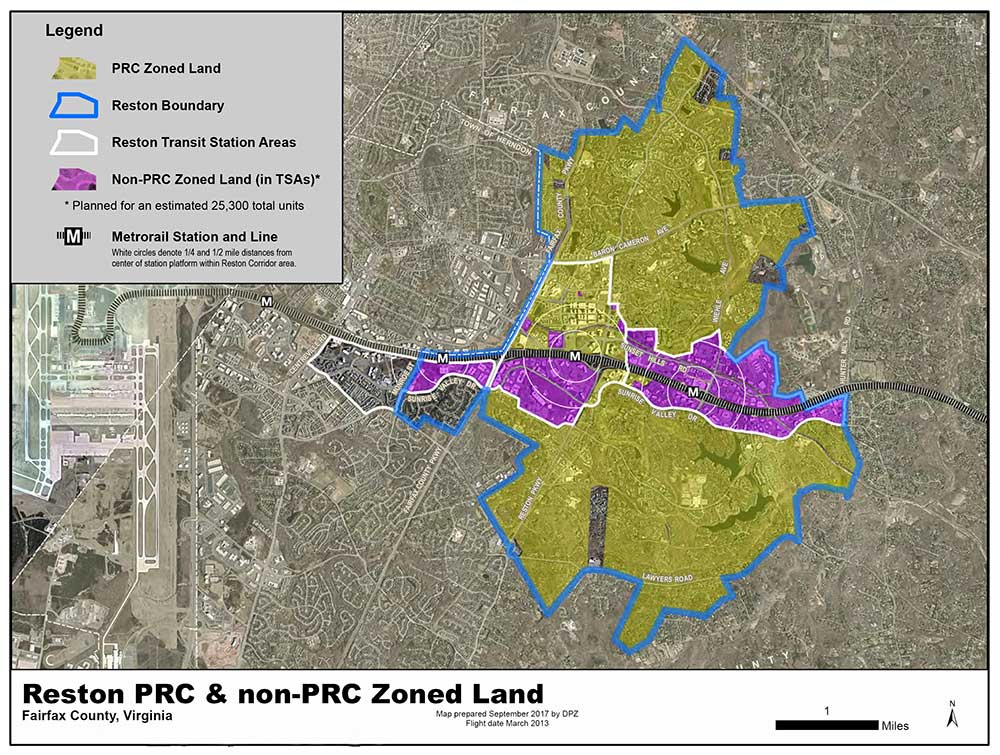Following 17 months of public engagement, Fairfax County will move forward with proposed zoning changes for Reston.
The Board of Supervisors is anticipated on Dec. 4 to authorize public hearings on the zoning changes for early next year. The Dec. 4 meeting will not be an opportunity for public input.
The proposal seeks to increase the maximum allowed “population” density from 13-persons per acre to 15 in the Reston Planned Residential Community (PRC) District. This 13-persons per acre limit has remained unchanged for several decades and does not accommodate the future residential growth anticipated in the Reston PRC near the future Silver Line Metrorail stations.

The other proposed change is to increase the limit of 50 dwelling units per acre to 70 in the transit station areas planned for mixed use development. This would mainly affect the Reston Town Center Transit Station Area.
County planning officials say the Reston PRC zoning change is needed to put into action Reston’s Master Plan that accommodates the potential for future growth during the next 40 years, especially around its Silver Line Metrorail stations. If the update isn’t ultimately adopted, Reston may lose its unique zoning designation that has shaped the community for the past 50 years, officials warn.
While some residents believe development in Reston would be halted if the zoning ordinance update isn’t passed, county planning officials say this is unlikely. However, developers may simply seek to rezone properties to other districts to build the development envisioned in the master plan. This could result in a patchwork of different zoning districts across Reston, ending the cohesive zoning that shapes most of the area today.
Reston’s primary zoning district is the “Planned Residential Community” District, and the ordinance includes a maximum, persons-per-acre density which is uncommon elsewhere and not applicable to any other zoning districts in the county. This density figure is not based on Reston’s actual, total population. Instead, it is based on a formula for household size multiplied by the number of housing units divided by the 6,245 acres in the PRC zoning district for Reston.
Today, there are approximately 12.46-persons per acre currently in the Reston PRC District based on the number of housing units built, under construction and approved to be built. County planners say the current 13-person cap may soon be exceeded based on development proposals that are under review now.
However, planners stress that the zoning changes do not facilitate residential development on either of Reston’s two golf courses. The master plan clearly calls for the Hidden Creek and Reston National courses to remain—and any proposals for residential development would require amendments to both the master plan and zoning ordinance. This is underscored by the county’s legal victory three years ago against one of the courses that failed in its attempt to redevelop without first seeking a change to the master plan.
Under Reston’s Master Plan, about 60 percent of future growth is concentrated around the three Metro stations. These are areas that would be largely unaffected by the person per-acre density maximums, and another 30 percent is located within the village centers where the limit would apply.
The master plan was adopted following a seven-year effort that ended in 2015. It included a community task force composed of residents and landowners; outreach to all of Reston’s 150-plus clusters, condos and apartments; and more than 200 community meetings.
County planning officials said they may consider some limited changes to clarify certain aspects of the Reston Master Plan based on feedback from residents. Namely, they might incorporate a population target and guidance for monitoring development levels and reporting outcomes on the plan's implementation annually, as was included in the plan for Tysons. However, these changes would ultimately need to be approved by the Board of Supervisors.
The Reston plan calls for new transportation improvements and the transportation strategy identifies required improvements, including the Soapstone Connector, Town Center Underpass and Reston Parkway widening. Last February, the Board of Supervisors adopted a $2.1 billion funding plan to help build new roads, improve intersections and construct new local connecting streets in the transit station areas.
New parks will be built following the guidance in the master plan. As a result of approved development proposals so far, there are over 30 acres of urban park spaces, plus a new athletic field, that have been pledged to the county.
# # #

